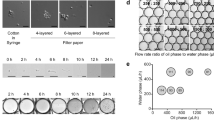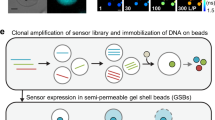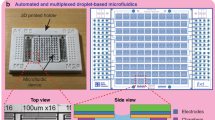Abstract
Phenotyping single cells based on the products they secrete or consume is a key bottleneck in many biotechnology applications, such as combinatorial metabolic engineering for the overproduction of secreted metabolites. Here we present a flexible high-throughput approach that uses microfluidics to compartmentalize individual cells for growth and analysis in monodisperse nanoliter aqueous droplets surrounded by an immiscible fluorinated oil phase. We use this system to identify xylose-overconsuming Saccharomyces cerevisiae cells from a population containing one such cell per 104 cells and to screen a genomic library to identify multiple copies of the xylose isomerase gene as a genomic change contributing to high xylose consumption, a trait important for lignocellulosic feedstock utilization. We also enriched L-lactate–producing Escherichia coli clones 5,800× from a population containing one L-lactate producer per 104 D-lactate producers. Our approach has broad applications for single-cell analyses, such as in strain selection for the overproduction of fuels, chemicals and pharmaceuticals.
This is a preview of subscription content, access via your institution
Access options
Subscribe to this journal
Receive 12 print issues and online access
$209.00 per year
only $17.42 per issue
Buy this article
- Purchase on Springer Link
- Instant access to full article PDF
Prices may be subject to local taxes which are calculated during checkout





Similar content being viewed by others
References
Alper, H., Fischer, C., Nevoigt, E. & Stephanopoulos, G. Tuning genetic control through promoter engineering. Proc. Natl. Acad. Sci. USA 102, 12678–12683 (2005).
Bailey, J.E. et al. Inverse metabolic engineering: a strategy for directed genetic engineering of useful phenotypes. Biotechnol. Bioeng. 52, 109–121 (1996).
Martin, V.J.J., Pitera, D.J., Withers, S.T., Newman, J.D. & Keasling, J.D. Engineering a mevalonate pathway in Escherichia coli for production of terpenoids. Nat. Biotechnol. 21, 796–802 (2003).
Atsumi, S., Hanai, T. & Liao, J.C. Non-fermentative pathways for synthesis of branched-chain higher alcohols as biofuels. Nature 451, 86–89 (2008).
Alper, H., Moxley, J., Nevoigt, E., Fink, G.R. & Stephanopoulos, G. Engineering yeast transcription machinery for improved ethanol tolerance and production. Science 314, 1565–1568 (2006).
Doshi, R., Nguyen, T. & Chang, G. Transporter-mediated biofuel secretion. Proc. Natl. Acad. Sci. USA 110, 7642–7647 (2013).
Liu, X., Sheng, J. & Curtiss, R. Fatty acid production in genetically modified cyanobacteria. Proc. Natl. Acad. Sci. USA 108, 6899–6904 (2011).
Wei, N., Xu, H.Q., Kim, S.R. & Jin, Y.S. Deletion of FPS1, encoding Aquaglyceroporin Fps1p, improves xylose fermentation by engineered Saccharomyces cerevisiae. Appl. Environ. Microbiol. 79, 3193–3201 (2013).
Sonderegger, M., Schumperli, M. & Sauer, U. Selection of quiescent Escherichia coli with high metabolic activity. Metab. Eng. 7, 4–9 (2005).
Weaver, J.C., Williams, G.B., Klibanov, A. & Demain, A.L. Gel microdroplets - rapid detection and enumeration of individual microorganisms by their metabolic-activity. Bio/Technology 6, 1084–1089 (1988).
Tawfik, D.S. & Griffiths, A.D. Man-made cell-like compartments for molecular evolution. Nat. Biotechnol. 16, 652–656 (1998).
Aharoni, A., Amitai, G., Bernath, K., Magdassi, S. & Tawfik, D.S. High-throughput screening of enzyme libraries: thiolactonases evolved by fluorescence-activated sorting of single cells in emulsion compartments. Chem. Biol. 12, 1281–1289 (2005).
Miller, O.J. et al. Directed evolution by in vitro compartmentalization. Nat. Methods 3, 561–570 (2006).
Link, D.R., Anna, S.L., Weitz, D.A. & Stone, H.A. Geometrically mediated breakup of drops in microfluidic devices. Phys. Rev. Lett. 92, 054503 (2004).
Ahn, K., Agresti, J., Chong, H., Marquez, M. & Weitz, D.A. Electrocoalescence of drops synchronized by size-dependent flow in microfluidic channels. Appl. Phys. Lett. 88, 264105 (2006).
Ahn, K. et al. Dielectrophoretic manipulation of drops for high-speed microfluidic sorting devices. Appl. Phys. Lett. 88, 024104 (2006).
Huebner, A. et al. Quantitative detection of protein expression in single cells using droplet microfluidics. Chem. Commun. (Camb.) 12, 1218–1220 (2007).
Agresti, J.J. et al. Ultrahigh-throughput screening in drop-based microfluidics for directed evolution. Proc. Natl. Acad. Sci. USA 107, 4004–4009 (2010).
Zhou, M., Diwu, Z.J., Panchuk-Voloshina, N. & Haugland, R.P. A stable nonfluorescent derivative of resorufin for the fluorometric determination of trace hydrogen peroxide: applications in detecting the activity of phagocyte NADPH oxidase and other oxidases. Anal. Biochem. 253, 162–168 (1997).
Zhu, A., Romero, R. & Petty, H.R. Amplex UltraRed enhances the sensitivity of fluorimetric pyruvate detection. Anal. Biochem. 403, 123–125 (2010).
Chundawat, S.P.S., Venkatesh, B. & Dale, B.E. Effect of particle size based separation of milled corn stover on AFEX pretreatment and enzymatic digestibility. Biotechnol. Bioeng. 96, 219–231 (2007).
Hahn-Hagerdal, B., Karhumaa, K., Jeppsson, M. & Gorwa-Grauslund, M.F. in Biofuels (ed. L. Olsson) 147–177 (Springer, Berlin, 2007).
Kuyper, M. et al. Evolutionary engineering of mixed-sugar utilization by a xylose-fermenting Saccharomyces cerevisiae strain. FEMS Yeast Res. 5, 925–934 (2005).
van Maris, A.J.A. et al. Alcoholic fermentation of carbon sources in biomass hydrolysates by Saccharomyces cerevisiae: current status. Antonie van Leeuwenhoek 90, 391–418 (2006).
Jeffries, T.W. Engineering yeasts for xylose metabolism. Curr. Opin. Biotechnol. 17, 320–326 (2006).
Wagschal, K., Franqui-Espiet, D., Lee, C.C., Robertson, G.H. & Wong, D.W.S. Enzyme-coupled assay for beta-xylosidase hydrolysis of natural substrates. Appl. Environ. Microbiol. 71, 5318–5323 (2005).
Smith, D.R. et al. Rapid whole-genome mutational profiling using next-generation sequencing technologies. Genome Res. 18, 1638–1642 (2008).
Ohnishi, J. et al. A novel methodology employing Corynebacterium glutamicum genome information to generate a new L-lysine-producing mutant. Appl. Microbiol. Biotechnol. 58, 217–223 (2002).
Zhou, H., Cheng, J.-S., Wang, B.L., Fink, G.R. & Stephanopoulos, G. Xylose isomerase overexpression along with engineering of the pentose phosphate pathway and evolutionary engineering enable rapid xylose utilization and ethanol production by Saccharomyces cerevisiae. Metab. Eng. 14, 611–622 (2012).
Zhang, J.Z. Evolution by gene duplication: an update. Trends Ecol. Evol. 18, 292–298 (2003).
Grabar, T.B., Zhou, S., Shanmugam, K.T., Yomano, L.P. & Ingram, L.O. Methylglyoxal bypass identified as source of chiral contamination in L(+) and D(−)-lactate fermentations by recombinant Escherichia coli. Biotechnol. Lett. 28, 1527–1535 (2006).
Baret, J.-C., Beck, Y., Billas-Massobrio, I., Moras, D. & Griffiths, A.D. Quantitative cell-based reporter gene assays using droplet-based microfluidics. Chem. Biol. 17, 528–536 (2010).
Yamashita, M. et al. Isolation, characterization, and molecular cloning of a thermostable xylitol oxidase from Streptomyces sp. IKD472. J. Biosci. Bioeng. 89, 350–360 (2000).
Sun, H., Treco, D., Schultes, N.P. & Szostak, J.W. Double-strand breaks at an initiation site for meiotic gene conversion. Nature 338, 87–90 (1989).
Siegel, A.C., Bruzewicz, D.A., Weibel, D.B. & Whitesides, G.M. Microsolidics: fabrication of three-dimensional metallic microstructures in poly(dimethylsiloxane). Adv. Mater. 19, 727–733 (2007).
Acknowledgements
We acknowledge support by Department of Energy Grant DE-FC36-07G017058, Royal Dutch Shell, and the Singapore-MIT Alliance. The authors would like to thank A. Abate for writing the LabView detection/sorting code, K. Humphry for her initial help on the project, Raindance Technologies for providing fluorinated surfactants and oils. We also thank the Ingram laboratory for providing strains TG108 and TG113.
Author information
Authors and Affiliations
Contributions
B.L.W., A.G. and G.S. planned the experiments, interpreted results and wrote the manuscript. B.L.W. developed the integrated microfluidic screening system and performed the xylose consumption experiments. A.G. performed the lactate production experiments. H.Z. created the xylose-consuming strains. H.Z. and B.L.W. constructed the yeast genomic DNA library and performed analysis on the high xylose–consuming strain. G.R.F. provided guidance in designing and constructing the yeast genomic DNA library. J.A. built the microfluidic detection and sorting stand. D.A.W. and J.A. provided technical advice regarding the microfluidic droplet system.
Corresponding author
Ethics declarations
Competing interests
The authors declare no competing financial interests.
Supplementary information
Supplementary Text and Figures
Supplementary Figues 1–15, Supplementary Table 1 and Supplementary Notes 1–8 (PDF 1430 kb)
Supplementary Video 1
Droplet formation of yeast or E. coli cells in growth medium (MOV 24156 kb)
Supplementary Video 2
Alternating sequence of cell-containing droplets and assay droplets (MOV 27739 kb)
Supplementary Video 3
Droplet coalescence of cell-containing droplets and assay droplets (MOV 15440 kb)
Supplementary Video 4
Sorting of “desired” droplets into the upper channel (MOV 21111 kb)
Rights and permissions
About this article
Cite this article
Wang, B., Ghaderi, A., Zhou, H. et al. Microfluidic high-throughput culturing of single cells for selection based on extracellular metabolite production or consumption. Nat Biotechnol 32, 473–478 (2014). https://doi.org/10.1038/nbt.2857
Received:
Accepted:
Published:
Issue Date:
DOI: https://doi.org/10.1038/nbt.2857
This article is cited by
-
High-throughput droplet microfluidics screening and genome sequencing analysis for improved amylase-producing Aspergillus oryzae
Biotechnology for Biofuels and Bioproducts (2023)
-
Advances in Synthetic Biology Tools and Engineering of Corynebacterium glutamicum as a Platform Host for Recombinant Protein Production
Biotechnology and Bioprocess Engineering (2023)
-
Recent Progress in the Development of Droplet-based Microfluidic Technologies for Phenotypic Screening using Cell-cell Interactions
Biotechnology and Bioprocess Engineering (2023)
-
Dual sequentially addressable dielectrophoretic array for high-throughput, scalable, multiplexed droplet sorting
Microfluidics and Nanofluidics (2021)
-
Multiple outcome particle manipulation using cascaded surface acoustic waves (CSAW)
Microfluidics and Nanofluidics (2021)



